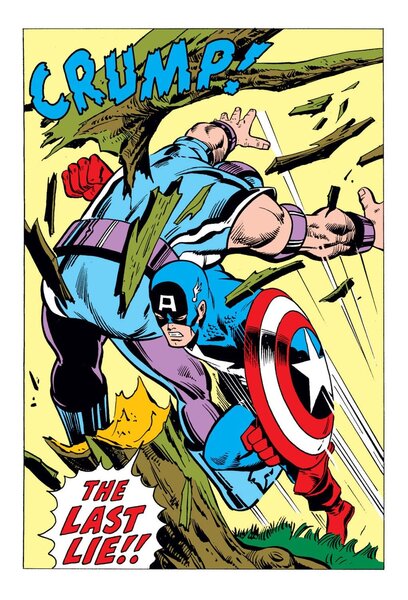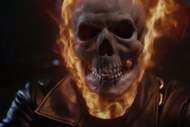Create a free profile to get unlimited access to exclusive videos, sweepstakes, and more!
Captain America's greatest enemy wasn't the Red Skull. It was propaganda.

As I watch the daily circus at the White House that masquerades as a press briefing on the pandemic, I often find myself tuning out the deflections and buck-passing and wondering if and how this story will make its way into comics.
During my recent Behind the Panel video interview with Tom King, he remarked that no other art form has the ability to address the pandemic in virtual real time like comics does. Sure, the printing presses are temporarily stopped, but writers are still writing. Artists are still drawing. When the presses start up again, and they will, comics will have a big head start on TV and film and could tell this story with an immediacy that no other medium could match. Tom even mentioned that the current unprecedented situation has actually led him to make changes to the story he set out to tell in the just-launched Strange Adventures maxi-series.
I can think of only one other time when a comics story paralleled a real-world event as it happened: the Captain America "Secret Empire" story.
No, not Nick Spencer's "Hail Hydra" one from 2017. I'm talking about the legendary 1974 Steve Englehart/Sal Buscema tale. It revolved around the hooded Secret Empire plotting to take down the United States from within and using a slick propaganda campaign to discredit its greatest symbol: Cap, the Sentinel of Liberty himself. It was typically fast-moving and overwrought, as most '70s Marvel comics were, loaded with plot threads, with guest appearances by Black Panther and the original X-Men.
Some elements of the story have certainly aged more gracefully than others, but it remains a great time capsule, in four-color fashion, of the disenchantment that permeated in large sections of America during the tail end of the Vietnam War. With its themes of propaganda and distrust in government leaders, it's as timely now as it was 46 years ago.
Originally presented in Captain American and the Falcon #169-176, it was a spandexed, super-powered riff on the Watergate scandal that was happening at the same time. When I talked to Englehart this week, he said he benefited from having much more creative freedom than most comics writers have today. "I didn't have to pitch anyone on the story," recalls Englehart. "Marvel just let me do my thing. The only two criteria I had were, are people buying the book, and am I getting it out on time? That was it."
The news cycle in the early '70s was also much different than today, when a scandal's shelf life is measured in hours, not days or weeks. Watergate played out for months on the evening newscasts of the three broadcast networks, so Englehart was not terribly concerned with the real-life scandal being wrapped up before his comic book tale. "I didn't know when I started how long it would go," the writer says. "But it didn't seem like it would come to a conclusion expeditiously. I actually ended it before Watergate ended."
The ending is what most people likely remember about the "Secret Empire" arc.
In the final page of Issue #175, Cap chases the leader of the evil group into the White House. In the Oval Office, he unmasks the person known as Number One – everyone in the Secret Empire was just assigned a number, because who the hell can remember every henchman's name? – and is gobsmacked by his identity. Number One then proceeds to commit suicide before a stunned Cap. While his face is never shown, it's patently obvious the villain beneath the mask was the villain at the center of the Watergate scandal: President Richard Nixon.
"It was my choice to not explicitly use Nixon or the president as the villain," Englehart remembers. "He was just Number One in the Oval Office. Saying it was Nixon might have been going over the line, even though no one had drawn the line. In the end, I decided to not show him. But everyone knew who it was."
One would expect a story that ends with a thinly disguised version of a scandalized U.S. president blowing his brains out in the White House would generate controversy. A year prior, the death of Gwen Stacy sparked a torrent of hate mail aimed at writer Gerry Conway. But Englehart doesn't recall much negative fan reaction at the time. "The vast majority of people reading Marvel in the '70s were young adults. It was in tune with the times," he notes.
The biggest villain in the story is not Number One but Quentin Harderman. He's the Madison Avenue adman who orchestrates the television smear campaign against Cap. The inciting incident is a TV montage that helps turn the public against the hero. Sure, J. Jonah Jameson had been doing it for years in The Amazing Spider-Man, but this was different. It was more subtle, more … sinister.
Harderman managed, in the span of just a few pages, to pull off something the Red Skull couldn't do: defeat Captain America without throwing single punch. There's a great bit of dialogue the second-tier villain Moonstone says at one point in the story that sums it up rather perfectly. "Lies are neat, truth is messy." Harderman's media blitz was a foreshadowing of the real-life propaganda wars that have become an everyday part of political life in the era of 24/7 TV news and hyper-partisanship. "I mean, Trump and the Republican Party has pushed it to its limits, but deceptive advertising has always been part of politics," Englehart notes. "Even back then. The difference is, Nixon wished things could be different, but he understood reality. Trump has spent his life making his own reality. I'm not sure he actually knows."
The "Secret Empire" story turned Cap's comic from an also-ran to Marvel's top-selling title in just half a year. It also catapulted Englehart's career. He would go on to have epic runs on The Avengers and The Defenders (a group he co-created with Sal Buscema), to name just two. But while many cite his classic Batman story "Strange Apparitions" as Englehart's high-water mark (and it is awesome), "Secret Empire" may be his most impactful work.
That story changed the trajectory of Captain America for all time. Immediately following the shocking suicide of Number One, Cap entered a period of self-reflection where he ditched the star-spangled spandex and shield and became Nomad. Disillusionment and debate over the difference between "loyal soldier" and "patriot" became perennial themes that numerous creative teams have revisited in the 46 years since Englehart and Buscema's tale, including in the MCU movies. Having that kind of impact on such a classic character is a badge of honor the writer wears proudly.
"I'm flattered by it," he admits. "I don't think Marvel and [then Editor-in-Chief] Roy Thomas expected me to be able to turn the book around. I was the new guy. But it hit me that Cap had to stand for America's ideals. I figured out what to do with him. I gave them a Cap fans could get behind. It pretty much gave me a career. And I'm pleased that it helped Cap."
Got a favorite Captain America story? Find me on Twitter/Facebook/Instagram and let me know!
And don't forget that Behind the Panel is a multi-platform series that can help keep you entertained during these strange and stressful times we're in. Our video series is chock-full of my in-depth interviews with amazing comic book creators. The Behind the Panel podcast is an audio documentary series that provides unique insight into your favorite creators and stories. Check 'em out, we think you'll enjoy them.
The views and opinions expressed in this article are the author's and do not necessarily reflect those of SYFY WIRE, SYFY, or NBCUniversal.





























